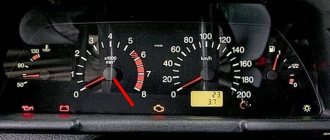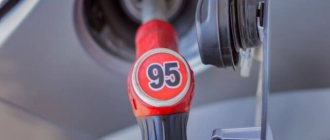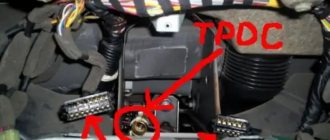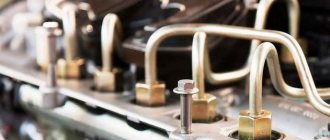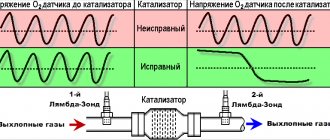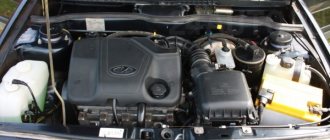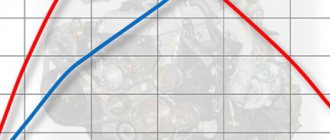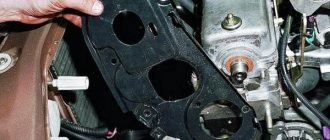The problem is this: uneven operation of the engine at idle, and jerking when starting off (The sensors are all changed, I had electrical diagnostics - everything is smooth. Compression is 1,2,4 - 10.5 in 3-8.5. It runs well after 2000, at speed 3 yesterday I accelerated from 40 to 110, it drives without hiccups. Has anyone had this happen? Video for clarity (when you press the gas, the sound near the mass air flow sensor is similar to air leaks). It jerks when starting off the VAZ 2114.
Similar articles
24 comments on “The VAZ 2114 jerks when starting. And jerks when starting”
Have you adjusted the valves recently?
Start with a description of the car! Lack of description in the TEXT is not respect for the reader. Measure the MAF ADC
Olga, this is a lottery for a couple of seconds. According to the rules in your stream
What is there to describe? VAZ 21093 approximately 2002 1.5 8kl engine works like a tractor
Egor, VAZ 2114 1.5 8 cells. 2004
You need to look at the valves
Maybe the firmware
Rasim, valves and air leaks. You can also check the spark plugs and wires
Spark plug, wire, module, or gasket burnt out. Or the belt jumped onto a tooth, or maybe the fuel filter turned into shit
Egor, could it be from a clogged fuel pump screen or a dying ignition module?
Rasim, perhaps both the mesh and the air flow sensor are dying. Measure the MAF ADC. If there was a module, the car would be very slow when accelerating
I had it because of the module and once because of a clogged throttle
DMRV has nothing to do with it! He says that he did the diagnostics
Rasim, the module has 2 failure options: 1st, 2 pots turn off... 2nd, all pots turn off for a short time
Guys, the question is, what could happen to the alarm? I set the doors to not close?
Mikhail, were there any jerks when starting off and after switching? Now, to get moving, I give it 2000 rpm so as not to stall. Yes, and you can hear small pops from the muffler
Egor, the gap with dips appeared gradually after changing the fine filter, which is located next to the tank. Also, when you open the neck, you can hear the pressure being released, then this did not happen! The funny thing is that before this there was another problem with XX, often the speed on the contrary rose to 1200-1400, but did not float.
The mileage of 120t itself had a similar problem. As a result, three exhaust valves have a gap of 0.15 when the norm is 0.35, that’s the whole reason
Rasim, it looks like there's something wrong with the gas supply. Check the mesh, tank ventilation, pump pressure...
Igor, is the firmware broken?
It was exactly the same. I washed the throttle, changed the spark plugs, and reset the brains, now everything is fine. I don’t know what I did that helped. Aren't the candles black by any chance?
Rasim, the adsorber purge does not work because it squeaks. I'm in trouble right now. The current kpa was stuck in the open position and was leaking from it. So the traction dropped a little. Start with the valve clearances. Measure it or drive it to a hundred. Why am I driving them, you can hear a knock in the video. But the video won’t convey the whole picture)
Anton, it could have flown off after replacing the sensors
Anton, and as a rule, after replacing the sensors you need to reset the brain
Theme Options
Answer: Vibration when starting off VAZ 2114
This is exactly what happened under the USSR, because there was such a thing as a shortage
. Although, if you don’t have time to scrap, you have plenty of time, you do this procedure yourself, then you can change it in parts so that all clutch parts wear out 100%.
Well, you haven’t found the reason yet, so it’s too early to say anything. In general, the most correct and justified way, if you want to save money, is to disassemble
, and then
identify
the parts as “good” and “faulty”. Then start shopping for what you need. If time is precious and you want to gain confidence in the unit (in this case, the clutch mechanism), then it is safer to change the entire set at once and forget about the problem.
Answer: Vibration when starting off VAZ 2114
If the car jerks, it's the clutch. In this case, it is not possible to move the car without jerking, no matter how many revolutions the engine makes when releasing the clutch. The car still jerks. Reason: when at intersections they stand for 2-3 minutes with the clutch engaged, which leads to the clutch springs being deformed and the clutch disc not being pressed evenly against the flywheel. Ultimately, this leads to uneven wear on the disc. In this case, I would recommend replacing the entire clutch.
The main reasons for increased vibration when starting to move.
- If you have a car with a manual transmission and the shaking started after replacing the clutch kit, then most likely the problem is in the clutch disc.
In this case, to get rid of the vibration you need to replace the clutch disc with a new one of better quality.
- The second reason, which is much more common, is faulty engine and gearbox mounts.
Due to faulty engine or gearbox mounts, the engine begins to rock when starting to move. This is where the increased vibration comes from.
If the faulty support is not replaced in a timely manner, the vibration will begin to increase over time because other supports will begin to fail due to increased load.
It is necessary to inspect the engine and gearbox mounts and replace the faulty mounts with new ones. Even small cracks in the supports can cause increased vibration.
Thank you for your attention, have a nice day!
Source
Answer: Vibration when starting off VAZ 2114
That's it - problem solved. I took it apart and looked and the driven disk was 50 percent worn out, but I replaced it anyway (after 20-30 thousand I have to disassemble it again). — The release valve is normal (I also changed it). But the basket - on the petals there is wear of 50 percent of the thickness of the petal itself, the petals are at different levels, the ends of the petals are purple (burnt metal). In general, the basket was not particularly lucky. I completely replaced the entire clutch with a German KRAFT one. Even though the release valve is new, it howls just like the old one. It started moving smoothly without jerking (that is, the airbags have nothing to do with it) - although there are cracks on the left pillow (the end of the gearbox) - it’s about to break - in short, it’s useless, but the shops are already closed - I’ll change it later. In other words, the left pillow does not affect vibration.
A machine is a complex mechanism that copes with enormous loads during operation. Therefore, you should not be particularly upset if any node fails or does not work as it should. Any car breaks down - it's only a matter of time. Drivers often complain on forums that their car jerks when starting from a stop. The reasons for this phenomenon may be different. Let's try to figure them out.
Why does the engine vibrate at idle on a VAZ-2114?
The clean and stable operation of the engine of any car often depends on a variety of different factors. If on our VAZ-2114 engine vibration at idle makes itself felt at least from time to time, it is necessary to urgently take action, since, as doctors say, inaction is like death. In the case of any engines that were installed on the “fourteenth model,” there is no need to hesitate, regardless of whether it is an injection engine or a carburetor. Vibration and floating idle can be harbingers of very serious breakdowns, which are easier to prevent than to fix.
Riding style
Speaking about why the car jerks when starting from a stop, we need to start with the obvious. The very first and most obvious reason is a harsh clutch. If you start, add gas and suddenly release the clutch pedal, the car will definitely jerk. Therefore, first of all, you need to try to change your driving style. At a minimum, when starting off, you need to release the clutch pedal very slowly and add a little more gas. However, you shouldn't press the gas pedal too hard.
However, if with an automatic transmission the car jerks when starting, then you won’t be able to change your driving style here, because there is simply no clutch pedal. But even with a manual transmission, the problem may be different. If the car still jerks even when starting smoothly, the problem is clearly not a sudden grip of the clutch discs.
Why does the VAZ Ten move jerkily?
Applied to a car jerk
- this is a short-term spontaneous change in the engine crankshaft speed, regardless of the position of the accelerator (“gas”) pedal. In everyday use, as a rule, there are a series of jerks. The extreme case of a jerk is a failure - a noticeable delay in the engine's response to pressing the accelerator pedal.
Conventionally, three types of jerks can be distinguished:
- at the moment of starting movement;
— with steady motion, i.e. with the accelerator pedal in constant position.
To determine the causes of jerking when moving
A car with an injection engine requires special diagnostic equipment, so in this case we recommend contacting a service specializing in the repair of fuel injection systems. However, as practice shows, in most cases jerking is caused by insufficient fuel pressure in the fuel rail, malfunction of the throttle position sensor or mass air flow sensor.
If you have some skills, you can determine the cause of jerking yourself.
A jerk at the start of movement.
At the moment the movement begins, the limiting case of a jerk—failure—most often occurs. The most unpleasant sensations are associated precisely with the delay in the engine’s response to pressing the gas pedal. Sometimes the engine even stalls. A jerk occurs at the moment the throttle valve begins to open, when, based on a signal from the throttle position sensor, the ECU determines the moment of transition from idle mode to load mode and must increase the amount of fuel supplied through the injectors. If the pressure in the fuel line is insufficient (even if the injection duration is increased), there is not enough fuel for a smooth start. It is necessary to check the fuel pressure in the rail or the fuel pump itself.
The cause of jerks during acceleration may be, as in the previous case (“Jerk at the moment of starting movement”), insufficient fuel pressure in the fuel line. The electronic engine control unit, having received a signal from the throttle position sensor about the intensive opening of the throttle at a large angle, strives to maximize the fuel supply, but due to the reduced fuel pressure it is not able to do this. The reasons for this phenomenon and the method of verification are the same as in the previous case.
Jerks during steady motion.
Such jerking is most often caused by a malfunction of the ignition system. Diagnosis and repair are required. Along the way, you can try the following on your own:
— carefully inspect the engine compartment. Turn off the ignition and check the secure fastening and seating of all wires (including high-voltage) and connectors of the ignition module. Start the engine and listen to its operation: the crackling sound when the high voltage breaks down to ground is weak, but distinct. In complete darkness, the spark during breakdown is clearly visible.
-replace spark plugs regardless of their condition and mileage. Pay attention to the condition of the spark plugs: if it is “abnormal,” the engine or its systems may need to be repaired.
A specific cause of jerking during steady motion of a car with an injection engine may be a failure of the throttle position sensor. Additional symptoms confirming the malfunction of this sensor are:
- uneven operation of the engine at idle.
-reduction of maximum engine power.
The sensor is non-separable and therefore cannot be repaired. If a sensor malfunction is detected, it is replaced as an assembly.
If you liked it?! Share with a friend or girlfriend or a plus from the heart. Thank you so much, friends. (Social networks connected in August 2013)
Your reviews, comments, questions and answers on LADA-10.ru
Everyone is welcome to participate in the discussion about the causes of the malfunction and other problems. If you know what to answer, write and thereby help other VAZ 2110 owners in searching for the truth.
Comments on the LADA-10.ru website were launched on January 11, 2012
Hello everybody. car VAZ 2112 8kl. moves jerkily. The failures are minor, but very unpleasant. what was done: 1. spark plugs and wires were replaced 2. connected to a hundred with a scanmaster (sort of). All tests are good. all sensors are working. characteristics are normal. 3. cleaned the injectors 4. checked the pressure in the fuel rail. 5. checked compression.
I don’t know where else to dig. Help. thank you in advance!
External and internal CV joints
If some suspension parts are poorly secured, then when driving (especially during a sharp start), they can cause the car to jerk. First of all, you need to check the inner and outer CV joints. The inner CV joint transmits rotational energy from the gearbox to the axle shafts and then to the wheels. This element is quite important, and if problems arise with it, it must be changed. This can be done at any service station. Features of failure of the inner CV joint are as follows:
- When destroyed, the inner CV joint becomes loose and can turn when transmitting forces, especially at the start.
- On a straight road without the smallest potholes, the inner CV joint can knock. In this case, it will seem that a dull knock is coming from the wheels.
- Outer CV joints may crunch when turning. If destroyed, they can also cause the car to jerk when starting off.
- Usually, internal CV joints simply wear out and because of this they fail. However, rarely the gearbox can cause a breakdown of this unit. This happens in cases where there is something wrong with the box itself.
- Outer CV joints can break due to impacts or careless driving on a bad road.
If your VAZ car jerks when starting from a stop, then first of all you need to check the CV joints. Often on forums when discussing a similar problem, users point to this particular node. Considering the prevalence of these cars and the cheapness of spare parts, repairing this element is unlikely to be expensive. It is worth noting that a similar problem occurs on the VAZ-2114 car. When starting off, the car jerks, but after replacing the CV joint (“grenade”), the problem disappears.
You will be very lucky if the problem turns out to be in the car's CV joints. These are inexpensive items that are easy to replace. It is much worse if a fault is discovered in the gearbox.
Shock when starting
Model 14, when you drop the clutch a little sharper, you feel a strong blow - the clutch and the airbags are new, the gearbox has been rebuilt. If anyone complains, please give advice on how to eliminate this hemorrhage
CV joints? front suspension? (steering fingers, ball.)
The topic has nothing to do with Tuning. Moved.
Check the crabs just in case.
most likely they are. like a backlash in the internal grenades I have the same problem on 09
drives 4 pcs., balls, steering, crabs, sales blocks, new struts. The impact remains as it was. I’ll change the clutch again on Tuesday, we can give it a ride
Buy a new car What do you mean by hit? Strong click? or what?
On the lift to the service station. behind the wheel and gas/shift. and they look... Maybe they slipped some shit grenades.
I tell you: you stand and press the pedal harder, you immediately throw a blow, and so on always. If you press the gas and release it more smoothly, then everything is clear
did it on a zebra, maybe you know
Last edited by support; 01/17/2010 at 12:11 pm.
My stretcher was beating at one time) check the protection again)) we bent it specially from a friend because it was beating on the crankcase when starting off
I know what loose and broken bolts are.
The right engine mount also unscrews very well.
Didn't you scratch your belly in the snowdrifts? The protection can bend and the kicker can hit and knock; a friend recently had this fixed.
Vibration usually goes through the protection to the body.
My heart senses that this is the impact of the satellites + play in the CV joint splines and the CV joints themselves
a friend recently had the same problem on a shlanos, they changed the drive and everything went away
Grenades usually crunch when you turn the steering wheel, look at the daisies on the suspension extension, my advice is if you change the daisies, install polyurethane ones, they are more reliable and last longer.
+1 I’ve been experiencing something similar since I bought the car. Rebuilding the gearbox and replacing the clutch + rubber-to-metal suspension parts did not lead to anything. When turning any of the drive wheels in a gear, play is felt. I believe this is the total backlash. Maybe the author has the same thing?
Transmission problem
The gearbox may well be the reason why the car jerks when starting off. However, there should also be other signs of a gearbox malfunction: difficulty shifting all or any one gear, a strange sound from this unit, etc. If this happens on the “mechanics”, then the problem is not so bad. In this case, the box itself can be repaired, and due to the simplicity of its design, repairs will not be so expensive. But if this problem is in the automatic transmission, then this is already serious.
Jerks when cold
Many owners of the VAZ 2110 note that jerks occur when cold, and after warming up, the car gets into a rhythm while driving and stops “sausaging”. The main reason in this case is called a lean mixture, due to the fact that air is sucked in at idle. Or one of the sensors “died”.
If dips often occur when cold (as well as when driving), in addition to everything already listed, you need to check:
- spark plugs - if they have heavy carbon deposits, and even make poor contact with the wires, this needs to be corrected urgently. In the first case - by replacement, in the second, by cleaning and strengthening contacts;
- high voltage wires. Checked with an ohmmeter (multimeter). But if they even look old and shabby, it’s better to just replace them all at once;
- ignition coil. You need to check the armored wires and the ignition module while wearing rubber gloves, otherwise you may get a slight electric shock if there is a break;
- The timing belt can jump a couple of teeth, then when cold there may well be failures. Therefore, check whether the marks on the pulleys match. If not, the belt must be removed and set correctly;
- be sure to check the oxygen sensors (OS); mass air flow (MAF); idle air regulator (IAC), if a malfunction is detected, replace them;
- filters. In principle, they need to be checked first, even before serious damage occurs. Air and fuel filters are designed to give cars a clean mixture. That is, they take on all the debris particles, so they become clogged, worsening the dynamics of the car, and also increasing fuel consumption. They need to be changed regularly.
If you have checked everything, tried to fix it, but nothing helps, you need to look for the reason only in the engine itself.
It is possible that the fuel injectors in a fuel-injected vehicle are clogged. Then you will need professional diagnostics in the service.
You should not miss one more point, because of which, when cold, as well as when driving, metamorphoses such as twitching can occur with the car: did you put the right gasoline in it? Advice to all car enthusiasts is always relevant: if possible, refuel at a reliable, proven gas station. Low-quality fuel can not only cause jerking, but also damage not only the fuel pump, but the entire engine.
Source
Do they repair gearboxes?
In any case, you will have to go to a service station, where they will examine the car and issue a conclusion. If the automation fails, repairs will be quite expensive. However, if any gear from the mechanism breaks down, the box, in principle, can be disassembled and a separate element replaced, but this is also a rather painstaking and complex procedure, and it costs money.
Note that quite often service stations do not undertake to repair automatic transmissions at all. Often they are simply replaced, but there are craftsmen who agree to restore these units, which allows the owner to save money.
Steering gear
If the steering mechanism is faulty, a similar problem can also occur. If the steering rack has any malfunction, it can create jerks when starting. In this case, the worn parts of the rack are simply replaced, and the problem disappears.
Also, the steering rack tips may have strong play. As a result, during a sharp start or braking, or increase in speed, so-called steering wheel wobble may occur. Bent tie rods result in a sharp jerk of the steering wheel to one side when starting off. This problem requires a quick solution.
Other elements of the steering system, including bushings and silent blocks, can cause the car to knock and jerk when driving. All this applies to the steering mechanism - it can be the reason why, for example, a GAZelle car jerks when starting off. But GAZelle is not the only brand where such breakdowns occur.
Note that problems with the steering mechanism are easier to solve than problems with the automatic transmission. However, the steering mechanism requires urgent repair for the safety of the driver and passengers.
"Personal" motives
The cases listed above are the main reasons why the steering wheel twitches when driving a VAZ-2114. Moreover, this is observed when starting or accelerating. However, it should be taken into account that each vehicle has individual characteristics, which are comparable to the human body.
In other words, each car has its own “diseases” and the appearance of the “symptom” in question is precisely due to the presence of design flaws.
Fuel system
If the fuel mixture is supplied to the combustion chambers of the engine in the wrong amount, jerking may occur when driving. This can happen if the car owner fills the tank with poor quality fuel or gasoline that the car is not designed for. For example, if a Euro-4 or Euro-5 engine is supplied with fuel with a high sulfur content (92 gasoline), it will wear out quickly. Some injectors may also become clogged, causing the wrong amount of fuel to be delivered. This can lead to jerking at start, but the “symptoms” can be different: loss of power, detonation, increased gas consumption.
Problems with other elements
Quite often, Opel cars jerk when starting from a stop due to problems with the exhaust gas recirculation valve. This valve is a headache for many Opel owners with Ecotec engines. As a result of the formation of soot on the valve, it may simply become clogged, and then an incomprehensible mixture consisting of fuel, air and waste exhaust gases will enter the combustion chambers. This is fraught with loss of power, increased consumption and, possibly, jerks at start.
Therefore, it is very important to fill only high-quality gasoline, and not save on buying fuel suitable for your engine. The same can be said about oil. Under no circumstances should you fill in oil with the wrong viscosity or additives!
What to do if vibration appears after replacing engine mounts
If the vibration after replacing the engine supports is caused by the use of non-original parts, then you need to buy and install new ones. If the vibrations are caused by unreliable fastenings, it is necessary to secure the elements. If the geometry of the mounting bracket is violated, it is necessary to correctly place the mount or replace it with a new one.
The most common cause of vibrations after replacing engine mounts is an incorrectly adjusted position of the power unit. You can adjust its position by changing the positions of the upper and lower supports (torque struts), which are responsible for reliable fixation of the motor at the time of gear shifting, picking up or decelerating.
We recommend
“Oil leaves the engine: we understand consumption rates and problems” More details
To eliminate vibration after replacing the engine mounts, you need to raise the car with a jack, remove the right front wheel, loosen the lower and upper mounts (they must be movable). Using a wooden plank, slightly lift the power unit. Taking a ruler or tape measure, you need to raise the internal combustion engine and estimate the distance between points A and B, which should be equal to 11.9 cm (4.7″). Before lifting the top, bottom or middle supports, you should mark the location of the old supports with a marker.
Vibration after replacing engine mounts can be caused by such reasons as misfire, compression differences, spark plugs, high-voltage ignition wires, etc. These problems may not appear in any way earlier, but will worsen after replacing the mounts.
To avoid such troubles, it is worthwhile to diagnose the internal combustion engine before starting to replace elements.
"Brains" of the car
A special program decides in what proportion to mix fuel with air and feed it into the combustion chambers. If the program makes an error, then the engine will receive a mixture with an incorrect air/gasoline ratio, which can also cause the car to jerk when starting off. An oversaturated or undersaturated mixture may be fed into the combustion chambers, then a batch of normal mixture may enter the system, after which improper mixing occurs again - all of which can easily cause the car to jerk, both when starting and when driving at speed. This may also be accompanied by popping noises from the exhaust pipe or lack of engine response to the gas pedal.
How to prevent this?
The following tips are a little banal, but effective. At a minimum, you need to fill your car with high-quality gasoline with the correct octane number. The instructions for the car must indicate what fuel should be poured into the tank.
This also applies to oil. It is necessary to use only the lubricant recommended by the manufacturer. Taking into account the presence of counterfeit oils on the market and low quality fuel, it is necessary to change oils even more often than the car manufacturer recommends. At a minimum, after 8-9 thousand kilometers the lubricant must be replaced. This will extend the life of the motor.
In general, you need to operate the car carefully. If you put a heavy load on the engine at least once and heat it up to the “red zone” on the thermometer, then problems with the engine can arise constantly. In this case, jerking when starting is far from the worst problem.

